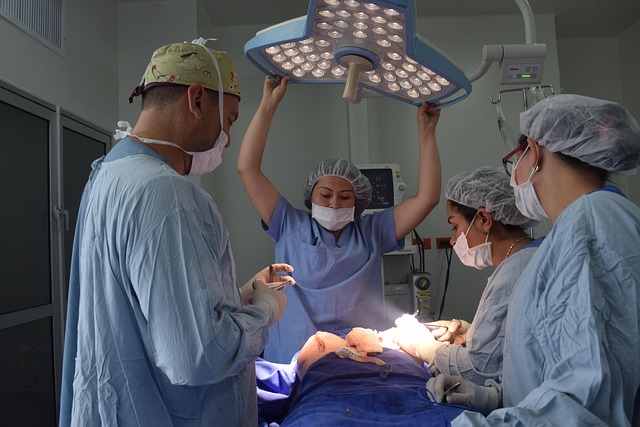Cosmetic surgery liability coverage is crucial for practices to manage risks from medical complications, patient dissatisfaction, and unexpected outcomes. Comprehensive insurance protection includes general liability and professional liability insurance, safeguarding against lawsuits and ensuring patient safety. By strategically choosing tailored policies, practices can maintain financial stability, instill trust in patients, and navigate legal challenges in a competitive market. Effective risk management strategies include rigorous patient screening, staff training, infection control, and clear communication to mitigate liabilities associated with cosmetic surgery procedures.
In the realm of plastic surgery, where precision meets art, understanding the intricacies of cosmetic surgery liability risks is paramount. This comprehensive guide delves into the essential coverage components tailored for plastic surgeons, navigating legal challenges unique to aesthetic procedures. From protecting patients and managing risks to crafting specialized policies, this article offers insights for professionals seeking optimal protection in today’s competitive landscape. Discover how to mitigate liabilities and ensure patient safety through strategic insurance obligations.
- Understanding Cosmetic Surgery Liability Risks
- Essential Coverage Components for Plastic Surgeons
- Protecting Patients: Insurance Obligations
- Navigating Legal Challenges in Aesthetic Procedures
- Tailoring Policies for Specialized Practices
- Best Practices for Risk Management in Cosmetics
Understanding Cosmetic Surgery Liability Risks

Cosmetic surgery, while offering transformative benefits, comes with unique risks that necessitate specific insurance considerations. Practices must grapple with potential liability issues stemming from procedures like breast augmentations, facelifts, or nose jobs. These risks can arise from medical complications, patient dissatisfaction, or even unexpected outcomes. Without adequate cosmetic surgery liability coverage, practices could face significant financial burdens resulting from lawsuits or claims for medical malpractice.
Understanding these risks is crucial in crafting a comprehensive risk management strategy. Insurance providers offer tailored policies that protect practices against specific liabilities associated with cosmetic procedures. By evaluating their unique needs and potential exposure, practices can select the right coverage to safeguard their assets and ensure ongoing stability in an increasingly competitive market.
Essential Coverage Components for Plastic Surgeons

Plastic surgeons, like any medical specialists, require comprehensive insurance protection tailored to their unique practices. When it comes to cosmetic surgery liability coverage, several key components are essential to mitigate risks and ensure financial security. Firstly, general liability insurance protects against claims of bodily injury or property damage that may arise during surgical procedures or consultations. This includes coverage for accidental cuts, infections, or other complications.
Secondly, professional liability insurance, often referred to as malpractice insurance, is crucial for plastic surgeons. It safeguards against lawsuits related to alleged negligence, misdiagnosis, or poor treatment outcomes. Given the highly specialized nature of cosmetic surgery, this coverage ensures that surgeons can manage potential legal risks without compromising their financial stability.
Protecting Patients: Insurance Obligations

In the realm of cosmetic surgery, protecting patients goes beyond exceptional care; it also involves adhering to strict insurance obligations. Practices must navigate a labyrinthine landscape of liability coverage tailored to mitigate risks associated with various procedures. Comprehensive cosmetic surgery liability coverage is paramount, ensuring practices are shielded against unforeseen incidents that may arise during surgeries or post-operative care.
This coverage plays a pivotal role in safeguarding patients and maintaining the integrity of the practice. It includes compensation for medical malpractice claims, providing financial protection if a patient alleges harm due to substandard care. By prioritizing these insurance obligations, cosmetic surgery practices can foster trust with their patients, ensuring that any potential risks are minimized and managed effectively.
Navigating Legal Challenges in Aesthetic Procedures

Navigating legal challenges is an integral part of running a plastic surgery practice. As the field of cosmetic surgery continues to evolve, so do the associated risks and potential liabilities. One of the primary concerns for practices is ensuring adequate cosmetic surgery liability coverage. This type of insurance protects both the patient and the surgeon by providing financial safeguards in case of unexpected outcomes or medical malpractice claims.
Legal complications can arise from various factors, such as informed consent issues, surgical errors, or complications related to anaesthesia. Comprehensive liability coverage should address these scenarios, offering financial protection against legal fees, settlement costs, and potential judgments. By carefully selecting the right insurance policies, plastic surgery practices can maintain a high level of patient safety and protect their professional reputation in this competitive industry.
Tailoring Policies for Specialized Practices

In the realm of plastic surgery practices, tailoring insurance policies is paramount. Cosmetic surgery liability coverage plays a crucial role in safeguarding both patients and practitioners from potential risks and financial burdens associated with procedures. Each specialized practice has unique needs, necessitating customized policies that address specific concerns like consent forms, informed consent, and rare but serious complications.
Practices offering a range of cosmetic services—from aesthetic enhancements to reconstructive surgeries—require comprehensive coverage reflecting this diversity. Insurers should consider factors such as the types of procedures performed, patient demographics, and the experience levels of the surgical team to craft policies that offer adequate protection. This tailored approach ensures that the practice is equipped to navigate legal complexities and financial challenges, fostering a safe and reliable environment for patients seeking cosmetic surgery.
Best Practices for Risk Management in Cosmetics

Effective risk management is paramount in the cosmetics industry, especially with the rise of cosmetic surgery procedures. To mitigate potential liabilities, practices should prioritize a comprehensive approach that includes thorough patient screening and informed consent processes. It’s crucial to ensure patients understand the risks, benefits, and alternatives before proceeding with any procedure. Regular staff training on safety protocols and up-to-date knowledge of industry standards is essential.
Additionally, maintaining detailed records, including patient medical histories and post-operative care instructions, can significantly reduce the risk of complications. Implementing robust infection control measures and adhering to best practices for sterile procedures are game-changers in preventing adverse outcomes. Moreover, establishing clear communication channels between staff, patients, and referral sources fosters a culture of transparency, enhancing overall safety and fostering trust.
